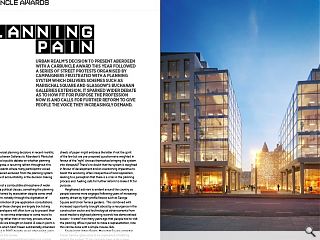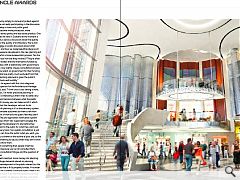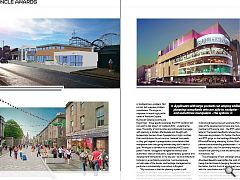Carbuncle Awards: Planning pain
15 Apr 2015
Urban Realm’s decision to present Aberdeen with a carbuncle award this year followed a series of street protests organised by campaigners frustrated with a planning system which delivers schemes such as Marischal Square and Glasgow’s Buchanan Galleries extension. It sparked wider debate as to how fit for purpose the profession now is and calls for further reform to give people the voice they increasingly demand.
A spate of controversial planning decisions in recent months; from Glasgow’s Buchanan Galleries to Aberdeen’s Marischal Square, has sparked a public debate on whether planning laws are fit for purpose, a recurring refrain throughout this year’s Carbuncle Awards where many participants voiced frustration at perceived exclusion from the planning system and anger at a lack of accountability in the decision making process.This is set against a combustible atmosphere of wider discontent with the political classes, something the planning system finds itself tarred by association despite some small steps toward reform; notably through the digitisation of records and the promotion of pre-application consultations. In practice however these changes are largely box ticking exercises where developers will often turn up to present their ideas and attempt to convince attendees to come round to their way of thinking rather than a two-way process where ideas from the public are brought on board. A case in point is Buchanan Galleries which hasn’t been substantially amended since first emerging in 2007, despite seven intervening years of protest, comment and review.
Consultations with a representative holed up in a hotel room on a weekday a bowl of sweets and some printed sheets of paper might embrace the letter if not the spirit of the law but are pre-prepared questionnaire weighted in favour of the ‘right’ choices themselves bringing the system into disrepute? There’s no doubt that the system is weighted in favour of development and an overarching imperative to boost the economy, often irrespective of local opposition, leading to a perception that there is a crisis in the planning process and fuelling calls for further reform to make it fit for purpose.
Heightened activism is evident around the country as people become more engaged following years of increasing apathy, driven by high-profile fiascos such as George Square and Union Terrace gardens. This combined with increased opportunity brought about by a resurgence in the construction sector and technological advancements from social media to digitised planning records has democratised access - it wasn’t too many years ago that people had to visit the planning office in person to make a representation, now this can be done with a simple mouse click.
Speaking to Urban Realm, Marischal Square protester Fraser Garrow, gave voice to his experience of battling against the system: “It has certainly been quite a steep learning curve, before joining the campaign I effectively had a blank canvas when it came to planning law/procedure. We now know more but probably nowhere near enough. I understand the need for it to be very technical and detailed but there also should be a degree of accessibility for the lay man - this is currently lacking.
“From speaking to people that supported our campaign but not involved with it, a lot were very surprised that decisions that affect so many people can be decided by a single planning committee or council. This is something that has interested me greatly, I’ve researched a little and found some interesting ideas along the lines of public juries.”
But have lessons and strategies learned left Garrow better prepared for the next fight? “Yes and no, we are certainly better equipped with the knowledge to be asking the right questions to ensure procedure is being followed. But being the ‘underdog’ we will always have to accept that developers will have much greater resources than ourselves, in terms of money and time, this might be the hardest obstacle to overcome. With this in mind we have now formed a group dedicated to ensuring the beauty of Aberdeen (www.aberdeenbeautiful.com) with particular attention to future development and regeneration.”
One of the great positives of campaigning is a heightened awareness of the benefits of good design, not just a misguided nostalgia for a long-gone past but an appreciation of good modern design. Garrow said: “The fight against Marischal Square has certainly engaged the public in thinking about design. And it is no secret that many residents of Aberdeen look enviously at Dundee right now with the Waterfront project and Kengo Kuma’s V&A building. It is encouraging to sit in the pub or coffee shop and over-hear discussion about architecture/design/space in Aberdeen, keeping this engagement up is the problem. For some time Aberdeen has accepted second rate development in the city, it has now culminated in this and I suspect - and hope - that future development will be scrutinised to a much greater degree.”
The issues affecting Aberdeen sparked a wider debate in the mainstream media with former Prospect editor Penny Lewis, now a tutor at Robert Gordon University, informing the BBC’s Scotland 2015 current affairs programme that there is now a ‘crisis in the planning process’. Lewis said: “You’ve got politicians who struggle to define what’s in the public interest and a public who are deeply cynical about the motives of developers and politicians when it comes to the planning process. The way in which the public get involved is usually as a stage army simply to come and protest against development, we’re not really participating in the discussion about how we develop a vision and public good.
“Planning has become more procedural, more bureaucratic, more about policy and less about product. One of the problems that we have in Scotland at the moment is that there isn’t really a serious discussion about the quality of urban design and the quality of architecture. We’ve lost our capacity to engage in public discussion about what constitutes beauty and how we make beautiful places and I think a lot of the measures developed in the new planning act have actually made for a more bureaucratic process. Yes the public are involved but how are they involved? They’re often non-governmental bodies that are themselves funded by government or bodies with a relationship with government, so you have a very cosy slightly cliquey consultation process with people who are reliant on government for their funding and the general public are pretty much excluded from that process so when planning approval is given the public’s reaction is one of shock and hostility.”
Asked whether he agreed with this crisis diagnosis Euan Leitch, spokesperson for the Architectural Heritage Society of Scotland, said: “I think crisis is too strong a word, planning is a process, I’ve never practiced planning or studied it but what’s interesting is that it tries to settle very broad differences and tensions between what the public want and how much money you can make out of it, which fundamentally is what the developer sets out to do.
“My concern with planning is it’s a discretionary system, so it doesn’t give concrete outcomes so there is risk from a development point of view and the public feel they don’t have any say in it. The pre-application notification system was one of the things which was supposed to engage the public but it requires the developers to say before they submit an application to the public for what they want and the guidelines are very basic. So a public consultation is just that, an event. You can show the public what you want, you can show them your scheme or the outline of your site, so the public may have something to say but often they won’t know if you’ve nothing to show them.
“But if you show something then people might be genuinely annoyed because you’ve not consulted them. There’s potentially consultation fatigue and the question of whether it’s genuine.
“The government could put more money into planning because there are huge demands placed on planning services to deliver development in the public interest but the only way you can do that is if it’s properly funded. A number of local authorities are currently cutting budgets, there is no way that is going to result in an improved planning service.”
Another commentator to disagree with the crisis label was Tom Parnell, convenor of the AHSS Forth & Borders cases panel, who told Urban Realm: “The planning system in Scotland has a problem. Not a crisis, but a serious problem nonetheless. The anger in response to recent high profile cases of Marischal Square, Buchanan Galleries and the old Royal High – three specific examples the RTPI Scotland ‘did not want to talk about’ on Scotland 2015 – underline the issue. The ability of communities and individuals to engage with planning is limited, oftentoolate and fraught with bureaucratic barriers. Even if people time it right, so often their contributions do not count as ‘material’ comments, or they get trapped in preapplication consultations that manipulate them into giving answers they don’t want to give. Writing as a convenor for a voluntary AHSS cases panel I’ll admit I struggle to navigate the various local authorities’ webs of local plans, supplementary guidance and development frameworks. In my day job – as an architectural historian in an architecture practice, I work extensively on both sides of the border, and heritage management in particular is substantially more robust in England.
“My conclusion is that the planning system is still designed by planners, for planners. Applicants with large pockets can employ skilled planning consultants who are able to navigate – and sometimes manipulate – the system: the demolition of three listed buildings in St Andrew Square in Edinburgh being one such example. Planners on both sides of the development process are more often than not members of the same club – the RTPI, which in a recent letter in The Herald steadfastly refused to acknowledge that there was any problem. On Twitter, the Scottish Government and RTPI gorge on the hashtags #HappyPlanner and #ProudofPlanning, alienating further. Most individual planners are outstanding professionals – I work with them on a regular basis – but I’m sure many would privately share my concern that planning is not the democratic and open system it should be. Yet.”
The emergence of new campaign groups such as Aberdeen Beautiful exemplifies the spirit of renewed vigour being directed toward changing the planning system for the better, the first fruits of which may become apparent with the consultation into Aberdeen’s future city centre masterplan. Amidst mounting public cynicism it will be a test case to see whether planners and the local authority are genuine in their desire to work with rather than against the weight of public opinion.
|
|
Read next: The Shields Centre
Read previous: Theatre Royal: Dramatic Entrance
Back to April 2015
Browse Features Archive
Search
News
For more news from the industry visit our News section.
Features & Reports
For more information from the industry visit our Features & Reports section.





